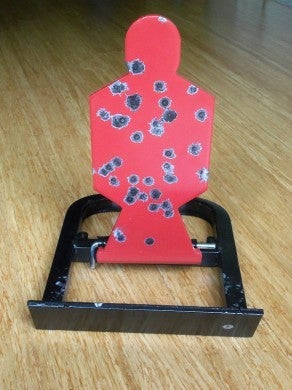A short time ago, I purchased a new steel target to shoot at with my various .22s, since the range I belong to has blessed us by allowing steel targets at 100 yards for rimfire. Since nothing more potent is allowed, I only needed a target to stand up to my .22 rifles. Said target is a Do-All Outdoors Body Shot, rated for .22/.17 caliber rimfire impacts.
The Body Shot is a decently sized steel silhouette, shaped vaguely like a human torso. It stands about 12” in height. The torso is roughly 5.5” wide and 7” tall, and the head is about 2.5” tall and wide. It sits on a tubular steel frame, attached by a hinge pin. The frame has 2 stake guides welded on it, to secure the target to the ground. It also has a large steel deflector on the front, to direct low misses into the ground, instead of into the frame or hinge mechanism. The hinge is spring loaded, so when shot, the target swings back, and then resets.
The target is made from mild steel, rated for .22 short, long, and long rifle at a minimum safe distance of 30 yards, and for .22 WMR and .17 HMR (and presumably .17 HM2) at a minimum distance of 100 yards. This target isn’t rated for centerfire calibers, and hitting it with such is likely to cause major damage to the target, including cratering and through-and-through penetrations. Both of these scenarios could cause dangerous splashback or ricochets. For safety reasons, the target plate is angled slightly forward, so impact fragments are mostly directed harmlessly into the ground. .22lr impacts at 100 yards leave superficial dings in the metal, nothing that would indicate a short target life, though.
The target is very easy to assemble, it involves sliding a removable hinge pin through the frame, target, and two rebound springs, with disassembly for flat storage or transport equally simple. The hinge pin has a bent-over end on one side so it cannot walk out of the frame while being used. Staking the target down (with the included stakes) is probably unnecessary, due to its weight, but it is a reasonable precaution to prevent the target from moving.
One of my favorite elements of this plate is that it is large enough to be shot at with iron-sighted rifles at 100 yards, yet it is not so large as to be too easy to hit with a scoped rifle. For an extra challenge with a scope, the head zone provides a 2.5” wide and tall target. When hit with standard velocity .22 LR, the target makes a very audible ping, since there is no sonic crack during bullet flight. When shooting with high or hyper velocity .22, I found the sonic crack of the bullet heading downrange tended to mask the sound of a hit somewhat, but it was still noticeable.
Since the plate is rather heavy, and the spring tension on the plate rather stiff (to allow the target to return after being tipped), .22 LR impacts at 100 yards will not move the target much at all. It is noticeable with a scoped rifle, but I did not notice impacts moving the plate when shooting with irons.
Typical prices online are about 80-90 dollars, which I consider a bit steep, for a target only rated for rimfire. I found it on sale for $35 plus shipping, and it seems to go on sale rather often on the web. At $35, I think it’s a stellar buy, and wouldn’t hesitate to buy again. At the normal online price, I’d consider it, but I probably wouldn’t have purchased it. All-in-all, as a fun little plinking target, I think it’s worth buying, if you can find a deal on it.
 Your Privacy Choices
Your Privacy Choices


